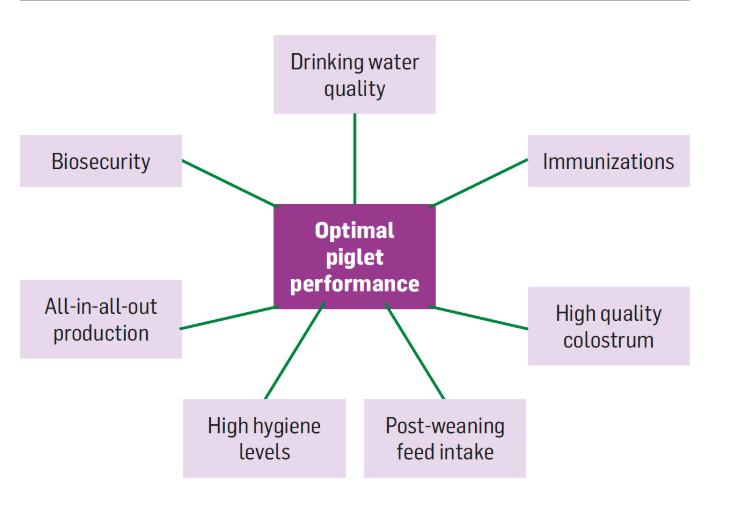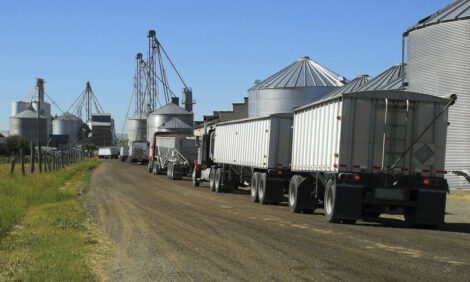



Life after zinc oxide - 3 tips for tackling post-weaning diarrhoea
Post-weaning diarrhoea is a problem for pig producers all around the world that has a big impact on future pig performance. With both antibiotics and now zinc oxide being removed from piglet diets in the EU, the pig industry is shifting its attention to new strategies to overcome this problem in young pigs.Author: Diego Padoan DVM Swine Technical Manager and Konstantinos Sarantis MSc Product Manager Mycotoxins
During weaning, the piglet is changed from a liquid diet to dry feed. The animal also has to adapt to new housing, often with new pen mates. This period of multiple stressors results in a dramatic decrease in feed consumption, leading to a nutrient deficit known as the post-weaning gap. Nutrient deficiency compromises the functionality of the gastrointestinal tract and its morphology, allowing pathogens to grow and thrive. In pig production units around the world, closing the post-weaning gap is a constant challenge. One of the most common pathogenic strains is enterotoxigenic Escherichia coli (ETEC), which causes post-weaning diarrhoea (PWD).
The rising popularity of zinc
Previously, PWD was commonly prevented by using in-feed antibiotics as growth promoters as well as antimicrobial agents. However, the increasing occurrence of antibiotic-resistant bacteria and the importance of some antibiotics to human medicine forced the European Union to ban antibiotics used as growth promoters. The ban came into effect on 1 January 2006. Today, other countries around the world have also followed this policy.
The first academic research into the efficacy of zinc oxide (ZnO) for use against PWD was presented in 1989 at the 40th annual meeting of the European Association for Animal Production held in Dublin. Although it was the first publication, the on-farm use of pharmaceutical levels of ZnO for avoiding PWD was already being practised across Europe at that time.
By the early 1990s, the use of ZnO to control PWD was common practice worldwide. Zinc oxide probably played a role in allowing the smooth transition away from antibiotic growth promoter use. Zinc oxide is currently permitted for use in the European Union under veterinary prescription. However, due to environmental concerns, the European Union was considering a ban on the medicinal use of ZnO. Manure rich in zinc can cause accumulations in the soil, posing a risk of run-off into underground water.
EU bans ZnO by 2022
At end of 2016, the European Medicines Agency Committee for Medicinal Products for Veterinary Use found that the environmental risks of using ZnO outweighed the benefits of diarrhoea prevention in piglets. The committee recommended a refusal on future authorisations for medicinal products containing zinc, and a withdrawal of approvals for existing products that contain zinc. From 21 June 2017, the EU gave all its member states up to five years to phase out ZnO at medicinal levels in piglet feeds. Any use of ZnO must be kept to 150 parts per million advised as the nutritional requirement for zinc in pigs; some publications state a lower level of 75 parts per million. Zinc is often used together with copper sulphate (CuSO4) which has a moderate constipating effect, decreasing the symptoms of diarrhoea.
Treating PWD without antibiotics or zinc
Antibiotic use in animal production is more likely to be replaced with multiple substitute products or combined approaches (Allen et al., 2013). According to Pluske (2013), future alternatives to antibiotics and ZnO include acidifiers, enzymes, fermentation and inoculation of feed, and prebiotics. The best results will be achieved when producers and stockpersons are trained and fully responsible for ensuring the quality of drinking water, providing the necessary immunisations, delivering high-quality colostrum and encouraging high feed intake post-weaning, maintaining high levels of hygiene, adopting all-in-all-out production processes, and enforcing biosecurity (Figure 1).
Figure 1. 7 key factors for optimal piglet performance
Colostrum and weaning
Colostrum is the feed of life. Each piglet must ingest a minimum of 3000 ml of colostrum to successfully face the challenges of the first weeks of life and weaning. First farrowing gilts have fewer antibodies and produce less colostrum, thus piglets born from these gilts receive less protection, they are the first to surrender to challenges at weaning, and they can compromise the growth of stronger piglets. Segregation of piglets from gilts at weaning is advantageous for the whole weaning batch.
Biomin solutions
Feed additive solutions are available and proposed to pig producers using a variety of management practices via local Biomin technical sales representatives. Including a mix of mycotoxin deactivators (Mycofix® product line), Gram-negative modulators (Biotronic® product line) and phytogenics (Digestarom® product line) in the diet will help to regulate the gut microbiome and achieve high levels of animal performance.
3 tips for tackling PWD without ZnO
1. Reduce stress as much as possible. Weaning is a very stressful time for piglets as their environment and diet change significantly. Where possible, minimise stress by gradually introducing change to the diet, and making the environment as comfortable as possible for them.
2. Train staff. Make sure that staff are fully trained on how to achieve optimal piglet performance. This includes ensuring clean and plentiful water is available, ensuring colostrum intake and monitoring post-weaning feed intake, administering immunizations, and upholding high standards of hygiene and biosecurity.
3. Use dietary supplements. Mycotoxin deactivators, Gram-negative modulators and phytogenic products added to the diet can alleviate dietary stress and support optimal development of the gastro-intestinal tract.
In Brief
- The post-weaning gap is caused by a decrease in feed intake when the diet is switched from liquid to dry feed. This usually results in PWD.
- PWD was commonly treated with antibiotics or with ZnO.
- Antibiotic use in feeds is decreasing, driven by consumer demand. And due to environmental concerns, the EU has banned medicinal levels of ZnO.
- There is no single product available as a substitute for antibiotics and ZnO. Combining various feed additives including mycotoxin deactivators, acidifiers and phytogenics will support the gut microbiome and maintain pig performance levels.
References:
Allen, H.K., Levine, U.Y., Looft, T., Bandrick, M. and Casey, T.A. (2013). Treatment, promotion, commotion: antibiotic alternatives in food-producing animals. ARS/USDA, 1920 Dayton Ave., IA, USA; DOI: http://dx.doi.org/10.1016/j.tim.2012.11.001
Pluske, J.R. (2013). The efficacy and potential for developing alternative additives and strategies to replace the role of antibiotic feed additives in pig production. An. Sci. Biotechnol, 2013; 4(1):1.









